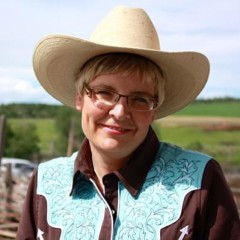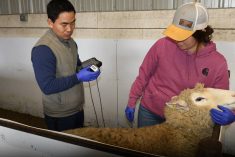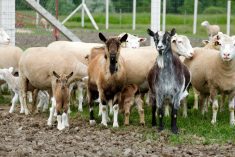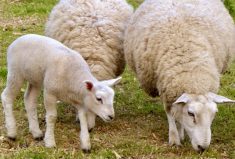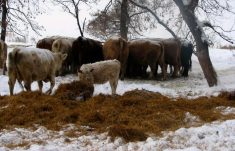A merger of two major players in the Canadian lamb sector is designed to be a game changer for the industry.
The deal brings together the country’s largest processor of federally inspected lamb (and also a major feeder) and one of the biggest sheep-farming operations in North America.
North American Lamb Company will control lamb production and marketing along the chain — from genetics to sales — and aims to become a global giant in sheep products. If successful, it will transform what has largely been a cottage industry.
Read Also

Farming Smarter receives financial boost from Alberta government for potato research
Farming Smarter near Lethbridge got a boost to its research equipment, thanks to the Alberta government’s increase in funding for research associations.
“The industry is really in a state of decline,” said Gary Alexander, president and CEO of North American Lamb. “The lack of supply, the lack of consistency. This is the lifeline for the SunGold plant.”
SunGold Specialty Meats has operated a four-decades-old processing plant at Innisfail since it was purchased by parent company Canada Gold Beef in 2011. Canada Gold has spent millions on upgrades and also built a huge feedlot at Iron Springs capable of finishing 50,000 lambs per year.
But getting lambs year round has been the major stumbling block to growth.
“Retailers want lamb 52 weeks a year and we want to be a solution provider,” said SunGold manager Miles Kliner.
The problem is that the lamb sector is dominated by small-scale producers and hobby farmers who lamb in spring, leading to a glut when those lambs are ready to market and shortages at other times of the year.
The ability to supply lambs throughout the year is what the other partner in the new company — Fresh Canada Meats — brings to the table.

Fresh Canada Meats (a subsidiary of Integrated Foods, a New Zealand lamb producer and processor) is the majority owner of Canada Sheep and Lamb Farms, a Manitoba operation with two breeding flocks totalling more than 35,000 head.
“They lamb every day of the week,” said Alexander. “So we have a 24-7, 365-day-a-year lambing operation, which is pretty unique in the sheep business throughout the world.”
Alexander, who was raised in Alberta, worked for Integrated Foods in New Zealand but is back in Canada to help with the merger. He knows the global marketplace for lamb.
“Even in New Zealand we struggle with seasonality because sheep are seasonal breeders,” he said. “So it’s really difficult to build a brand and continual supply to the consumer.”
The Manitoba flocks are composed of the Rideau Arcott breed, a Canadian line developed for lambing out of season and prolific production. The animals will be raised to a weight of 70 to 80 pounds and then shipped to Iron Springs for finishing.
North American Lamb Company plans to up the flock numbers in Manitoba to 50,000. There’s also plenty of room for expansion at the feedlot (which has the capacity to finish 200,000 lambs annually) and at the SunGold plant (which aims to more than double production to 200,000 head annually within five years).
“The merger is one of the few I’ve seen where it’s totally complementary,” said Alexander. “We’ve got assets and they’ve got assets and we’ve put them together and there’s nothing that overlaps or is redundant. It works really well.”
Once the base flock numbers are built up, terminal sire genetics will be introduced with more focus on carcass size and quality.
The new partners emphasize the merger does not mean established or new lamb producers will be shut out of the production chain. In fact, the new company will even be looking for more suppliers.
“There’s a huge opportunity to have lots more breeding done in Canada,” said Alexander. “If we had our production in Canada at 50,000 ewes… we’d still only capture about 10 to 12 per cent of the current Canadian market.”
But producers will have to meet the company’s protocols.
“To be frank about it, you need control,” he said. “If you don’t control you get chaos and we’ve seen plenty of that. It’s got to be someone who’s serious, disciplined, and who can accept standards.
“We have a term we call DIFOTIS, which is Delivery In Full On Time In Specification, and those are the things that we want to design our system to do. You can’t build consumer brands with variability.”
The market is ripe for expansion, said Kliner, adding that lamb is the only red meat in North America that’s gaining in consumption, and worldwide demand is growing.
“It’s a huge opportunity no one is seizing,” he said.
North American Lamb Company already has eyes on the U.S. market for lamb, as well as expanding beyond meat to markets for byproducts like sheep pelts and offal.
For those who may be concerned about the Canadian sheep industry teaming up with a New Zealand investor, Alexander counters the global sheep business is too small to be ‘parochial.’ Sheep production is declining in both Australia and New Zealand and global players need to look at the big picture, he said.
“I don’t think we’re all competitors. I think we should all be working together,” said Alexander. “There’s such a demand out there (for lamb) that isn’t being serviced that we can really rebuild this industry and make a viable consumer base using different geographies to overcome obstacles to seasonality.”

